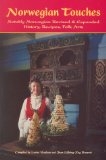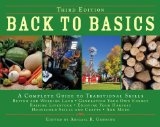-
History of:
- Resources about:
- More:
- Baby walkers
- Bakehouses
- Bed warmers
- Beer, ale mullers
- Besoms, broom-making
- Box, cabinet, and press beds
- Butter crocks, coolers
- Candle snuffers, tallow
- Clothes horses, airers
- Cooking on a peat fire
- Drying grounds
- Enamel cookware
- Fireplaces
- Irons for frills & ruffles
- Knitting sheaths, belts
- Laundry starch
- Log cabin beds
- Lye and chamber-lye
- Mangles
- Marseilles quilts
- Medieval beds
- Rag rugs
- Rushlights, dips & nips
- Straw mattresses
- Sugar cutters - nips & tongs
- Tablecloths
- Tinderboxes
- Washing bats and beetles
- Washing dollies
- List of all articles
Subscribe to RSS feed or get email updates.
...the dampened linen to be pressed was wrapped around the roller flat on a table and the roller was worked back and forth by means of the flat board, a downward pressure being exerted by the hand at the same time.
Edison Monthly, Jan 1922
Norwegian Touches: History, Recipes, Folk Arts Notably Norwegian by Louise Roalson, from Amazon.comor Amazon UK

Back to Basics: A Complete Guide to Traditional Skills by Abigail Gehring, from Amazon.comor Amazon UK
Mangle boards
Mangling board and pin, board and roller - carved or plain
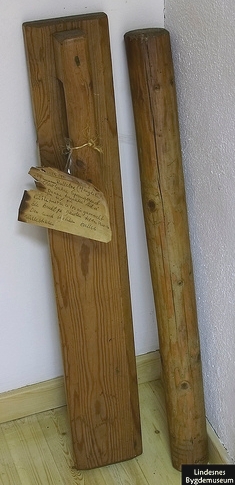 Hot
metal pressing irons are so common that we may forget how widespread wooden mangling
boards once were. People who have heard of mangle boards may know they were traditional
courtship gifts carved by young men in Scandinavia or the Netherlands. They were
found further afield too, and were a standard way of smoothing linen from Russia
to France, from Iceland to Bosnia. We know they were in use before 1600 and in some
places were still familiar in the 20th century.
Hot
metal pressing irons are so common that we may forget how widespread wooden mangling
boards once were. People who have heard of mangle boards may know they were traditional
courtship gifts carved by young men in Scandinavia or the Netherlands. They were
found further afield too, and were a standard way of smoothing linen from Russia
to France, from Iceland to Bosnia. We know they were in use before 1600 and in some
places were still familiar in the 20th century.
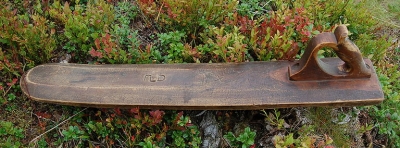 How
do they work? Like the 100-year-old Norwegian tools in the photograph, the board
was always one half of a pair. A roller was an essential companion to the board.
While the board could be beautifully decorated on one side - sometimes with carved
initials and dates - the roller had to be smooth and plain for effective "ironing".
How
do they work? Like the 100-year-old Norwegian tools in the photograph, the board
was always one half of a pair. A roller was an essential companion to the board.
While the board could be beautifully decorated on one side - sometimes with carved
initials and dates - the roller had to be smooth and plain for effective "ironing".
Two utensils are necessary - the first a kind of rolling-pin, round which the sprinkled linen is tightly swathed. The other, a mangling-board, a narrow flat piece of wood ... is then pressed tightly on the linen and rolled with as much force as possible.
Nico and Beatrix Jungman, Norway, 1905
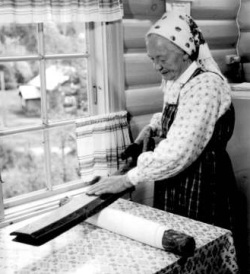 As well as the Norwegian woman pictured left, this photo from
Germany shows how the board was placed at right angles to the roller. Skill and experience
would make for a good rolling action, balancing heavy pressing with smooth motion.
Experience would help you know how damp the cloth should be, how best to wind it
etc. In some regions, a handle on top of the board helped you press down firmly.
As well as the Norwegian woman pictured left, this photo from
Germany shows how the board was placed at right angles to the roller. Skill and experience
would make for a good rolling action, balancing heavy pressing with smooth motion.
Experience would help you know how damp the cloth should be, how best to wind it
etc. In some regions, a handle on top of the board helped you press down firmly.
 Animal-shaped
handles like the horse were often favoured in Norway and Sweden, while the English
board from Whitby, Yorkshire pictured above left has a lion handle. In parts of
northern England these mangling tools were called a 'bittle and pin'. Attractive
carved boards could help decorate the home, as in this
picture from Marken, Holland
Animal-shaped
handles like the horse were often favoured in Norway and Sweden, while the English
board from Whitby, Yorkshire pictured above left has a lion handle. In parts of
northern England these mangling tools were called a 'bittle and pin'. Attractive
carved boards could help decorate the home, as in this
picture from Marken, Holland
 Originally this article said that the oldest dated mangle board was from 1566, and
kept in the Arnhem museum, according to the
Musée des civilisations de l’Europe et de la Méditerranée. In April 2011
Tonnis Prins kindly wrote to tell me about an even older one, from 1554, which is in
the Zuiderzeemuseum in the
Netherlands.
Originally this article said that the oldest dated mangle board was from 1566, and
kept in the Arnhem museum, according to the
Musée des civilisations de l’Europe et de la Méditerranée. In April 2011
Tonnis Prins kindly wrote to tell me about an even older one, from 1554, which is in
the Zuiderzeemuseum in the
Netherlands.
During the sixteenth century the mangling board and roller came into general use. The idea spread from Holland, Denmark and northern Germany.... The material was wrapped round the roller...which was placed on a flat table. The mangling board [was] then passed backwards and forwards over the roller until the fabric was smoothed.....The idea was exported by Dutch colonists, particularly to North America and South Africa.
Ian McNeil, Encyclopedia of the History of Technology, 1990
 The pictures on this page are not to scale, and some come from books published in
the early 20th century by authors who didn't record sizes, even though they were
experts in their subjects. (Like Charles Holme's books on 'Peasant Art'.) However,
we know the Norwegian board top right is about 70cm or 27 inches long. This is not
untypical for mangle boards from Scandinavia. Edward Pinto, author of
Treen and Other Wooden Bygones
The pictures on this page are not to scale, and some come from books published in
the early 20th century by authors who didn't record sizes, even though they were
experts in their subjects. (Like Charles Holme's books on 'Peasant Art'.) However,
we know the Norwegian board top right is about 70cm or 27 inches long. This is not
untypical for mangle boards from Scandinavia. Edward Pinto, author of
Treen and Other Wooden Bygones,
thought these were some of the heaviest boards because wood was abundant there,
and reports that boards from Friesland (northern Netherlands) were much lighter.
Ages are also not mentioned though some have dates from the 1700s or 1800s carved
into them.
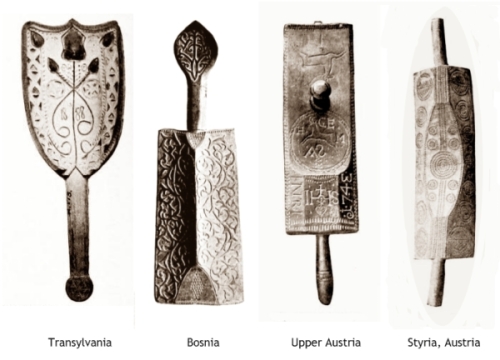
These batlers or battledores, as they are now generally called, are still in use in Yorkshire. They are the prototype of the "patent mangle", and consist merely of a flat rectangular piece of wood, some two feet long, and six inches broad, with a thin short handle. The linen to be mangled is coiled round a roller, which is placed on a table, and then the batler is placed on the top, and pushed forwards and backwards on the roll under pressure of the hands. They were not used in Yorkshire only. I procured a very handsome specimen in Suffolk some years ago, the upper surface of which is rather elaborately carved with a Gothic design. The initials of the owner are burnt in in Gothic letters-, and the article cannot have been made more lately than the beginning of the sixteenth century.
Notes and Queries, 1865
The last two pictures of mangle boards, with fine chip carving, come from Holmes' books, Peasant Art in Sweden, Lapland, and Iceland, and Peasant Art in Austria and Hungary, which includes areas of the old Austro-Hungarian empire like Transylvania, a Hungarian-speaking culture within modern Romania. Some are quite similar in shape to laundry bats. In parts of England mangling and washing boards/bats had similar regional names.
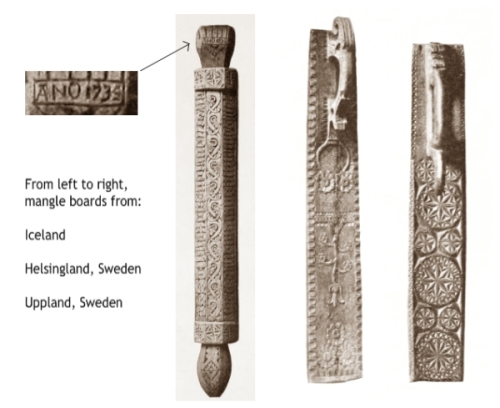 The concept of pressing linen with a weight and rollers was developed into the large
box mangle - illustrated and explained on the box mangle
page.
The concept of pressing linen with a weight and rollers was developed into the large
box mangle - illustrated and explained on the box mangle
page.
Words to help you google for more pictures: mangelbrett (German), manglebraet (Danish), mangelbräde, kavelbräde (Swedish), mangletre (Norwegian), mangelplank (Dutch), planche à calandrer (French)
 8 Jan 2010
8 Jan 2010
You may like our new sister site Home Things Past where you'll find articles about antiques, vintage kitchen stuff, crafts, and other things to do with home life in the past. There's space for comments and discussion too. Please do take a look and add your thoughts. (Comments don't appear instantly.)
For sources please refer to the books page, and/or the excerpts quoted on the pages of this website, and note that many links lead to museum sites. Feel free to ask if you're looking for a specific reference - feedback is always welcome anyway. Unfortunately, it's not possible to help you with queries about prices or valuation.


